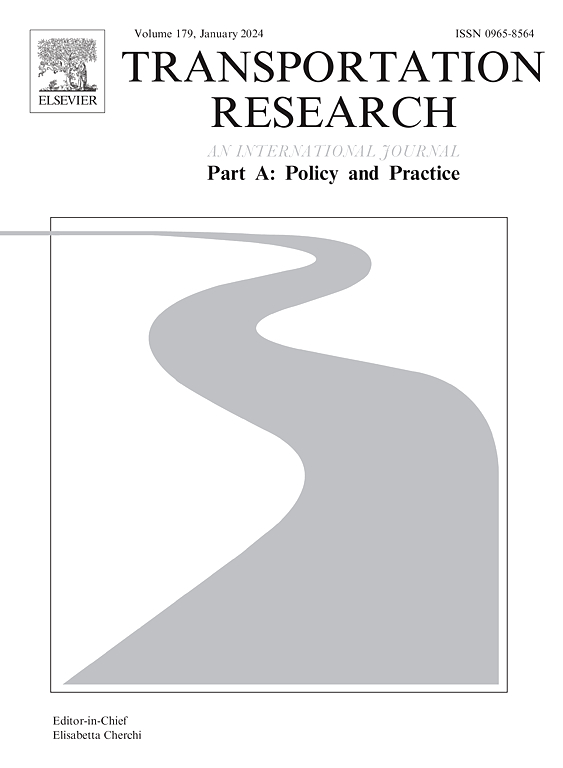建筑环境对交通拥堵有影响吗?-对墨尔本案例研究的自举中介分析
IF 6.8
1区 工程技术
Q1 ECONOMICS
Transportation Research Part A-Policy and Practice
Pub Date : 2024-11-02
DOI:10.1016/j.tra.2024.104297
引用次数: 0
摘要
虽然建筑环境、机动性选择和出行产品之间的关系已被充分记录,但建筑环境对交通性能,尤其是拥堵的影响却没有得到广泛的研究。在现有的研究中,建筑环境对交通性能的直接或间接影响机制仍不明确。此外,交通性能大多是通过综合和粗略的性能指标来量化的,无法反映交通的运行特征。本研究利用宏观基本图(MFD)将交通动态与建筑环境属性联系起来,研究建筑环境与交通拥堵之间的直接和间接关系。研究假设建筑环境对交通拥堵有间接影响,并利用引导中介分析法分析了可能的间接影响。其中,"运行能力 "和 "出行需求 "这两个要素被定义为中介因素。分析基于澳大利亚墨尔本地区 133 个二级统计区(SA2)收集的数据,包括 2019 年收集的交通和建筑环境数据。结果表明,"路网连通性 "和 "路网结构 "会加剧拥堵,而 "公共交通可达性 "则是减少拥堵的关键。分析还显示,"运行能力 "在这种关系中起着中介作用。值得注意的是,该分析发现的中介效应并不明显,这表明建筑环境可能会对拥堵水平产生更直接的影响。提出的分析方法和观察结果对规划者和决策者制定规划和基础设施发展战略具有实用价值。一个重要的启示是,必须评估对交通运行效率的影响,以确保通过明智和可持续的规划决策,积极缓解潜在的拥堵问题。本文章由计算机程序翻译,如有差异,请以英文原文为准。
Does built environment have impact on traffic congestion? —A bootstrap mediation analysis on a case study of Melbourne
While the relationship between built environment, mobility choices and travel productions has been well documented, the impact of built environment on traffic performance, particularly congestion, is not extensively investigated. In existing investigations, the mechanisms by which built environment affects traffic performance-whether direct or indirect-remain unclear. Furthermore, traffic performance is mostly quantified by aggregated and rough performance metrics that fail to capture the operational characteristics of traffic. This study examines both the direct and indirect relationships between built environment and traffic congestion using the macroscopic fundamental diagram (MFD) to connect traffic dynamics with built environment properties. The study hypothesizes that built environment has an indirect impact on congestion and analyzes the possible indirect effects utilizing the bootstrap mediation analysis. Two components, namely the “operational capacity” and “travel demand”, are defined as mediating factors. The analysis is conducted based on data collected from 133 Statistical Area Level 2 (SA2) in the Melbourne region, Australia, including both traffic and built environment data collected from 2019. Results show that “road network connectivity” and “road network structure” can intensify congestion, while “public transit accessibility” is critical in congestion reduction. The analysis also reveals that “operational capacity” serves as a mediating factor in this relationship. Notably, this analysis identifies less pronounced mediating effects, hinting that built environment may exert a more direct influence on congestion levels. The proposed analytical method and observations hold practical value for planners and policymakers in developing strategies for planning and infrastructure development. A critical takeaway is the imperative to assess the impact on the consequent operational traffic efficiency to ensure that potential congestion is proactively mitigated through informed and sustainable planning decisions.
求助全文
通过发布文献求助,成功后即可免费获取论文全文。
去求助
来源期刊
CiteScore
13.20
自引率
7.80%
发文量
257
审稿时长
9.8 months
期刊介绍:
Transportation Research: Part A contains papers of general interest in all passenger and freight transportation modes: policy analysis, formulation and evaluation; planning; interaction with the political, socioeconomic and physical environment; design, management and evaluation of transportation systems. Topics are approached from any discipline or perspective: economics, engineering, sociology, psychology, etc. Case studies, survey and expository papers are included, as are articles which contribute to unification of the field, or to an understanding of the comparative aspects of different systems. Papers which assess the scope for technological innovation within a social or political framework are also published. The journal is international, and places equal emphasis on the problems of industrialized and non-industrialized regions.
Part A''s aims and scope are complementary to Transportation Research Part B: Methodological, Part C: Emerging Technologies and Part D: Transport and Environment. Part E: Logistics and Transportation Review. Part F: Traffic Psychology and Behaviour. The complete set forms the most cohesive and comprehensive reference of current research in transportation science.

 求助内容:
求助内容: 应助结果提醒方式:
应助结果提醒方式:


